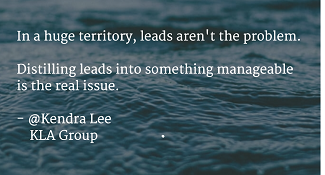A few weeks ago, I got an email from an inside sales rep responsible for drumming up new business aopportunities for his company’s team of outside sales reps. The challenge this rep was grappling with wasn’t figuring out how to generate leads. Instead, it was how to manage the massive size of his territory. Because it was so large, he was having trouble distilling his list of contacts down to something that was manageable.
Now, I realize that it might seem like a good problem to have so many leads that you’re struggling to decide which ones to pursue, but it’s a very real problem. Unfortunately, many reps address it by taking a shotgun approach — sending out generic messaging that might apply to a large swath of prospects, rather than taking a more personal approach to each lead.
As I wrote in my last blog post, A Simple Way to Achieve Email Personalization at Scale, the problem with a lack of personalization is that prospects don’t respond to generic messaging. Rather, they respond to emails, voicemails, and social messaging that feel like they were created just for them.
So, how can you do that and manage a huge territory? Here are three simple steps to follow:
- Identify smaller target markets: I like to call these “micro-segments,” but the general idea is to lump prospects into groups with similar traits that will be easier to manage. For instance, one micro-segment might be prospects that share the same pain point, or operate in the same geography. You can research and create one unique message for each micro-segment and save yourself valuable prospecting time.
- Choose appropriate attraction strategies: If you’re targeting business owners, the attraction strategies you use might vary greatly from those you deploy if you’re targeting CIOs. The same applies to geographies, company sizes, company revenue, etc. To give yourself the best chance of creating personal messages for a large territory, be sure to choose attraction strategies that best align with each target market.
- Create a campaign approach and use an email system: While tools tied to Microsoft Outlook can help you organize the messages you send, they aren’t the best for managing a huge territory. Conversely, Mail Chimp (which is free) and other email systems like it allow you to send emails in groups just like Marketing does. From there you can also create a short email campaign to send to your microsegment and see who opened each email. You can use that information to identify who you should call right away, and who isn’t paying attention.
Follow these three steps and you’ll be well on your way to drumming up more (and better) new business — even in a huge territory. To take your prospecting to the next level, check out our free Connected Lead Generation Strategy Infographic on the 14 different attraction strategies you can use and a planner to create your own strategy!




